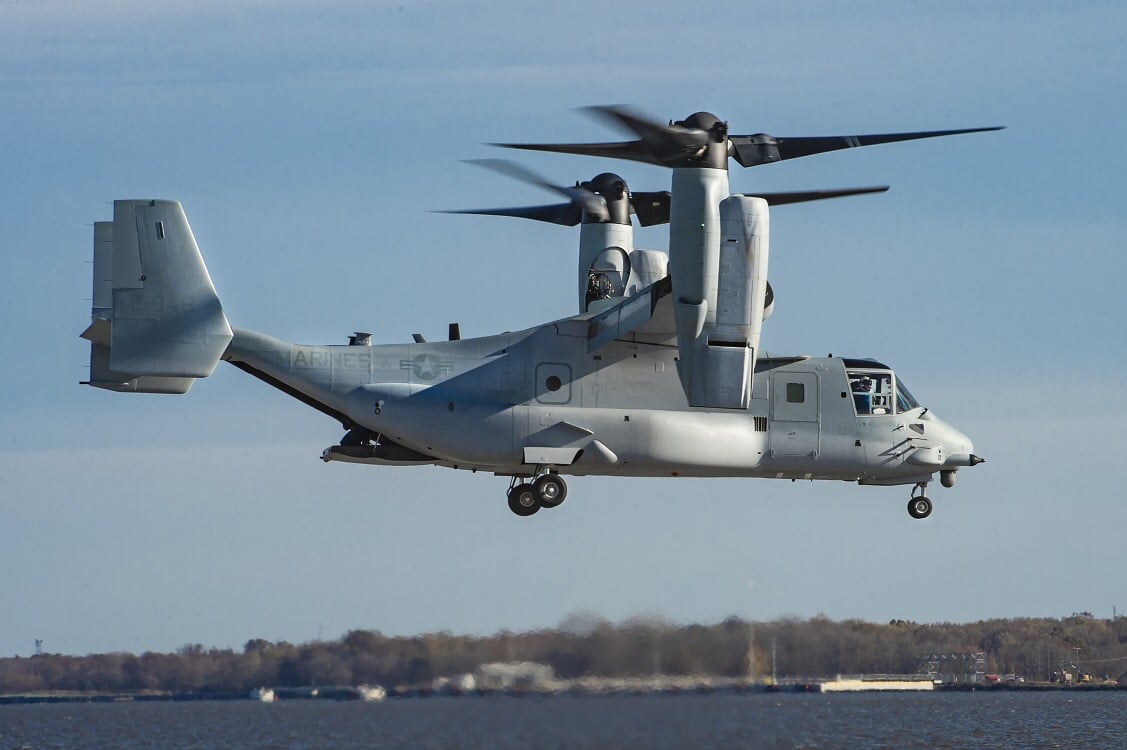Aerospace
Bell Boeing Delivers First Modified Osprey for Improved Fleet Readiness

PHILADELPHIA, Dec. 10, 2019 — Boeing [NYSE: BA] and Bell Textron Inc., a Textron Inc. [NYSE: TXT] company, have delivered the first modified MV-22 Osprey to the United States Marine Corps for improved readiness and reliability of the tiltrotor fleet.
The Marines have multiple configurations of the MV-22 aircraft in service. Under the Common Configuration – Readiness and Modernization (CC-RAM) program, Bell Boeing is reducing the number of configurations by upgrading block “B” aircraft to the current block “C” configuration.
“Our first CC-RAM aircraft returning to Marine Corps Air Station New River was a key program benchmark,” said U.S. Marine Corps Col. Matthew Kelly, program manager, V-22 Joint Program Office (PMA-275). “We are excited to see the capability, commonality and readiness improvements these CC-RAM aircraft bring to the fleet as part of the Marine Corps’ V-22 readiness program.”
As a block “B” configuration, this MV-22 was originally delivered to the fleet in 2005. In 2018, the aircraft flew from Marine Corps Air Station New River to the Boeing Philadelphia facility for modernization.
“This milestone marks the beginning of an Osprey evolution,” said Kristin Houston, vice president, Boeing Tiltrotor Programs and director, Bell Boeing V-22 Program. “Through a shared focus on safety and quality, the Bell Boeing team is delivering modernized MV-22 aircraft that are ready to serve our dedicated servicemen and women who rely on this essential aviation resource.”
The next CC-RAM delivery is expected in early 2020.
“We look forward to having the remaining MV-22 block “B” aircraft rejoin the fleet in a block “C” configuration,” said Kelly.
In November 2019, the U.S. Navy awarded Bell Boeing $146,039,547 to upgrade nine additional MV-22 aircraft under the CC-RAM program, with work expected to be completed in March 2022.

Aerospace
Boeing Transfers Rocket Stage to NASA, Paving Way for Human Moon Mission

Boeing has achieved a significant milestone by providing NASA with the second core stage of the Space Launch System (SLS) rocket.
This crucial component, crafted at NASA’s Michoud Assembly Facility (MAF), is set to propel the Artemis II crew into lunar orbit, marking humanity’s return to deep space after a 50-year hiatus.
The monumental Boeing-built rocket stage, the largest element of the Artemis II mission, will embark on a journey aboard the Pegasus barge, traveling 900 miles to NASA’s Kennedy Space Center.
Comparison of two legendary aircraft B777x vs B747 aircraft:Click here
Upon arrival, it will be meticulously integrated with other essential Artemis II components, including the upper stage, solid rocket boosters, and NASA’s Orion spacecraft within the iconic Vehicle Assembly Building. This intricate integration process is a vital step toward the eagerly anticipated Artemis II launch, slated for 2025.
“Boeing-built products helped land humankind on the moon in 1969, and we’re proud to continue that legacy through the Artemis generation,” remarked Dave Dutcher, vice president and program manager for Boeing’s SLS program. “Together, with NASA and our industry partners and suppliers, we are building the world’s most capable rocket and paving the way to deep space through America’s rocket factory in New Orleans.”
NASA, Lockheed Martin Reveal X-59 Quiet Supersonic Aircraft:Click here
The delivery of Core Stage 2 marks a significant achievement in the evolution of the SLS rocket. Towering over 200 feet and powered by four RS-25 engines, this core stage, coupled with two solid-fueled booster rockets, will generate a staggering 8.8 million pounds of thrust. This immense power is crucial to launching Artemis II and future missions into the vast expanse of space.
The SLS rocket stands unparalleled in its capability to transport both crew and substantial cargo to the moon and beyond in a single launch. Its extraordinary capacity will facilitate the delivery of human-rated spacecraft, habitats, and scientific missions to destinations including the moon and Mars, ushering in a new era of space exploration.
-

 Travel1 week ago
Travel1 week agoAir India to Expand US Operations with Three New Routes After a Decade
-

 Travel2 weeks ago
Travel2 weeks agoWhy We Should Avoid These Stamps in a Passport
-

 Airlines1 month ago
Airlines1 month agoInvestigations Reveal Fake Chinese Titanium in Boeing and Airbus Jets
-

 Tech4 weeks ago
Tech4 weeks agoChina’s CATL Plans 1,800-Mile Electric Plane Launch by 2027
-

 Airport3 days ago
Airport3 days agoTop 10 Largest Airports in the World by Size
-

 Aerospace4 weeks ago
Aerospace4 weeks agoChina’s Fighter Jets Turn Wings into Autonomous Drones
-

 Airlines4 days ago
Airlines4 days agoAir India Rolls Out A350s for Delhi-New York JFK and Newark Routes
-

 Defence3 weeks ago
Defence3 weeks agoBoeing Enhances Chinook with New Engines and Block II Upgrades at $96 Million







